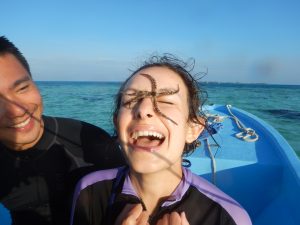After spending two weeks in Belize immersed in coral reef and tropical rainforest environments, I’ve gotten much deeper insight into these two ecosystems which have always fascinated me. I was surprised to learn that such biologically diverse ecosystems exist in nutrient-poor conditions. I always imagined that there would need to be a nutrient-rich foundation to sustain the plethora of organisms that live within each ecosystem, but that’s not the case – actually, for the coral reef it can be quite harmful. The stony corals that form the reef thrive in nutrient-poor environments and, as Ellie told us, if too many nutrients enter the system, the reef will undergo a phase shift which means that it will become overrun by algae. In the case of the rainforest, Sarah T. gave us the lowdown about how there is only a very thin layer of soil (the topsoil) which contains most of the available nutrients. The low levels of nutrients are caused in part by rapid nutrient recycling; as nutrients become available, they are quickly used by the many organisms that inhabit the two ecosystems.
Another similarity I noticed between the two ecosystems is how many symbiotic relationships there are. This is likely because the high species density in coral reefs and rainforests brings many organisms into close proximity, resulting in more specialized niches. An example in coral reefs that Sarah G. talked about is the mutualistic relationship between dinoflagellates and corals. The dinoflagellate provides photosynthetic products to the coral, while the coral provides shelter to the dinoflagellates. In the rainforest, a symbiotic relationship Scott and I discussed is when leafcutter ants cultivate fungus gardens. The fungus breaks down the leaves that the ants can’t digest, producing nutritious swellings called gongylidia. In return, the fungus receives shelter and protection.
Ultimately, the two ecosystems are more alike than I realized at first sight. Even though I had been to both a rainforest and coral reef before this course, I had never really connected the dots between the two. I had always separated them in my mind due to the obvious difference that one ecosystem is on land and the other is underwater. It was really interesting to look at them comparatively. Although there are some differences like coral reefs being more sensitive and susceptible to changing environmental factors when compared to rainforests, it’s become obvious to me now how much more they have in common.
This course went above and beyond my expectations which were to learn about field work and to look at coral reefs and rainforests through a more scientific lens than I had while on vacation. While I did come away with a greater knowledge of the ecosystems and a better understanding of being a field biologist, I also created friendships and had the most fun I’ve had in a while. I feel extremely lucky to have been part of such an amazing group. It was so interesting to watch everyone become comfortable with each other to the point where it became non-stop laughing and joking around. That was definitely the best part of the trip for me. Honestly, the only downside I can think of is that the weather didn’t permit for a night dive. With all the snorkeling and scuba diving I’ve done, I have never gone in the water at night which I thought that would be neat, but oh well.
I’ll definitely hold on to a lot of the things I’ve learned throughout the course, especially the experiential learning aspects of how science is done out in the field. It was fascinating to consider how many different directions a project can take, and how one observation can spark years of research. It’s kind of like how Therese’s work on defaunation in Gabon lead to her new project on seed-dispersal in Peru. I’ll also remember how important it is to talk to other people about their work. Scott and Adrienne really encouraged us to take advantage of where we were and to talk to the researchers at the stations. I’m normally not one to approach people I don’t know, but I made it a point to go out of my way to talk to the researchers at Glover’s and the archeology team at Las Cuevas. I’m glad I did because I got so much out of hearing their stories and listening to what they were working on. Lastly, I was completely surprised with how awesome ants are. To be honest, I wasn’t thrilled that I got ants as my taxon but I was quickly converted. I always thought it odd that my grandmother never killed the ants that crawled along the windowsills in her house, but now I understand. This trip ruined me – I’ll never be able to squish an ant again.
Until next time, Belize. Hopefully I’ll be back soon to dive the Blue Hole and swim with whale sharks. Sorry Scott, Team Surf for life.























